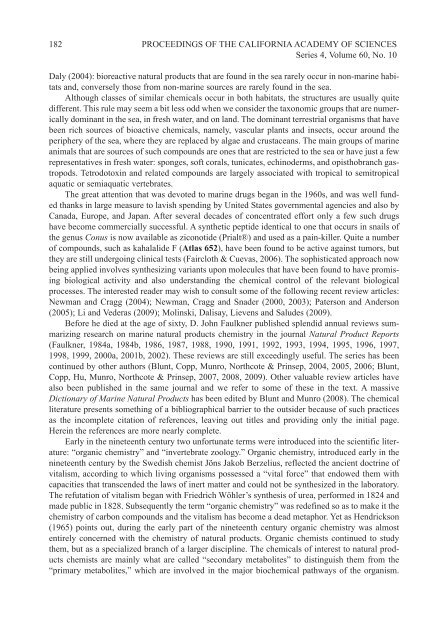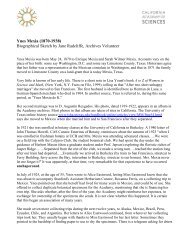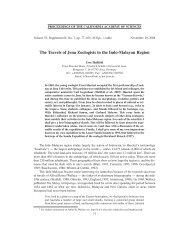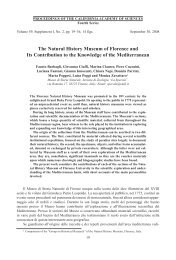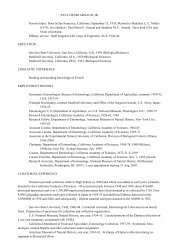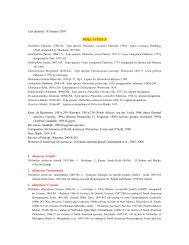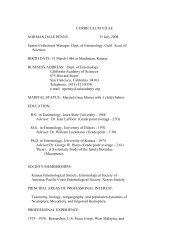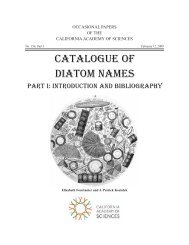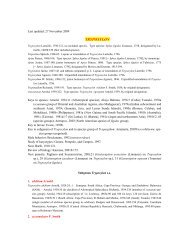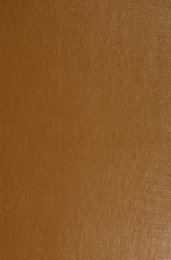Cimino&Ghiselin-tmpZXYZ:Template Proceedings_1.qxd.qxd
Cimino&Ghiselin-tmpZXYZ:Template Proceedings_1.qxd.qxd
Cimino&Ghiselin-tmpZXYZ:Template Proceedings_1.qxd.qxd
Create successful ePaper yourself
Turn your PDF publications into a flip-book with our unique Google optimized e-Paper software.
182 PROCEEDINGS OF THE CALIFORNIA ACADEMY OF SCIENCES<br />
Series 4, Volume 60, No. 10<br />
Daly (2004): bioreactive natural products that are found in the sea rarely occur in non-marine habitats<br />
and, conversely those from non-marine sources are rarely found in the sea.<br />
Although classes of similar chemicals occur in both habitats, the structures are usually quite<br />
different. This rule may seem a bit less odd when we consider the taxonomic groups that are numerically<br />
dominant in the sea, in fresh water, and on land. The dominant terrestrial organisms that have<br />
been rich sources of bioactive chemicals, namely, vascular plants and insects, occur around the<br />
periphery of the sea, where they are replaced by algae and crustaceans. The main groups of marine<br />
animals that are sources of such compounds are ones that are restricted to the sea or have just a few<br />
representatives in fresh water: sponges, soft corals, tunicates, echinoderms, and opisthobranch gastropods.<br />
Tetrodotoxin and related compounds are largely associated with tropical to semitropical<br />
aquatic or semiaquatic vertebrates.<br />
The great attention that was devoted to marine drugs began in the 1960s, and was well funded<br />
thanks in large measure to lavish spending by United States governmental agencies and also by<br />
Canada, Europe, and Japan. After several decades of concentrated effort only a few such drugs<br />
have become commercially successful. A synthetic peptide identical to one that occurs in snails of<br />
the genus Conus is now available as ziconotide (Prialt®) and used as a pain-killer. Quite a number<br />
of compounds, such as kahalalide F (Atlas 652), have been found to be active against tumors, but<br />
they are still undergoing clinical tests (Faircloth & Cuevas, 2006). The sophisticated approach now<br />
being applied involves synthesizing variants upon molecules that have been found to have promising<br />
biological activity and also understanding the chemical control of the relevant biological<br />
processes. The interested reader may wish to consult some of the following recent review articles:<br />
Newman and Cragg (2004); Newman, Cragg and Snader (2000, 2003); Paterson and Anderson<br />
(2005); Li and Vederas (2009); Molinski, Dalisay, Lievens and Saludes (2009).<br />
Before he died at the age of sixty, D. John Faulkner published splendid annual reviews summarizing<br />
research on marine natural products chemistry in the journal Natural Product Reports<br />
(Faulkner, 1984a, 1984b, 1986, 1987, 1988, 1990, 1991, 1992, 1993, 1994, 1995, 1996, 1997,<br />
1998, 1999, 2000a, 2001b, 2002). These reviews are still exceedingly useful. The series has been<br />
continued by other authors (Blunt, Copp, Munro, Northcote & Prinsep, 2004, 2005, 2006; Blunt,<br />
Copp, Hu, Munro, Northcote & Prinsep, 2007, 2008, 2009). Other valuable review articles have<br />
also been published in the same journal and we refer to some of these in the text. A massive<br />
Dictionary of Marine Natural Products has been edited by Blunt and Munro (2008). The chemical<br />
literature presents something of a bibliographical barrier to the outsider because of such practices<br />
as the incomplete citation of references, leaving out titles and providing only the initial page.<br />
Herein the references are more nearly complete.<br />
Early in the nineteenth century two unfortunate terms were introduced into the scientific literature:<br />
“organic chemistry” and “invertebrate zoology.” Organic chemistry, introduced early in the<br />
nineteenth century by the Swedish chemist Jöns Jakob Berzelius, reflected the ancient doctrine of<br />
vitalism, according to which living organisms possessed a “vital force” that endowed them with<br />
capacities that transcended the laws of inert matter and could not be synthesized in the laboratory.<br />
The refutation of vitalism began with Friedrich Wöhler’s synthesis of urea, performed in 1824 and<br />
made public in 1828. Subsequently the term “organic chemistry” was redefined so as to make it the<br />
chemistry of carbon compounds and the vitalism has become a dead metaphor. Yet as Hendrickson<br />
(1965) points out, during the early part of the nineteenth century organic chemistry was almost<br />
entirely concerned with the chemistry of natural products. Organic chemists continued to study<br />
them, but as a specialized branch of a larger discipline. The chemicals of interest to natural products<br />
chemists are mainly what are called “secondary metabolites” to distinguish them from the<br />
“primary metabolites,” which are involved in the major biochemical pathways of the organism.


